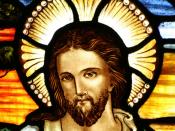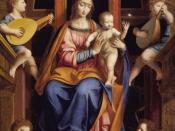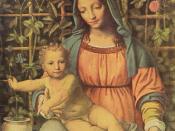The Conversion of Magdalene is a profound piece of art painted by a man named Bernardino Luini (1475-1533) of Italy. Having been delineated with oil paint onto canvas, the painting was able to appear three-dimensional and achieve a more realistic look. Mary Magdalene is portraying a worldly woman of sin. The light that radiates upon her is not really coming from any particular direction and yet ignites her face and breasts in a glowing fashion. This light is meant to bring focus on Magdalene's features and her conversion to purity. Her fashionable hairdo, the ovular shaped gem across her breasts, the bit of cleavage shown and the make-up on her face depicts worldliness and sin. The look on Mary's face is a soft, relaxed look, full of peace within her conversion, while Martha has a face of persuasion and distress as to coax Mary to come with her to Jesus.
While Martha gracefully gestures up toward heaven, Mary acknowledges her and responds with the same gesture as to commune she understands. The necklace that lay on the table signifies the commitment she has now made to the lord. In her left hand, Mary clenches a valuable jar which symbolizes the act of anointing Jesus'
feet and with that Mary dedicates herself to the Lord Jesus.
The Madonna and child with Saints is another profound piece of work done by and artist names Giovanni Di Paolo (1403-1483) of Italy. The Date of origin of this art is unknown but suspected about the 15th century. Tempera was the source of beauty in this case. Tempera is
achieved by mixing the pigments with water, egg yolks and sometimes glue. In Latin this word means to mix in due proportion. Tempera colors are bright and translucent. The one downfall is that it dries quickly,


